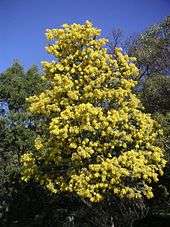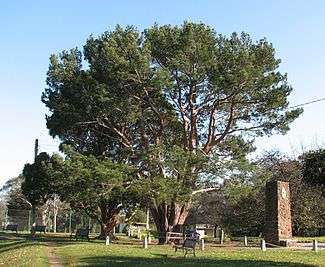Wattle Park, Melbourne
| Wattle Park | |
|---|---|
|
Wattle Park's Lone Pine | |
| Location | Melbourne, Australia |
| Coordinates | 37°50′20″S 145°06′16″E / 37.8390°S 145.1045°ECoordinates: 37°50′20″S 145°06′16″E / 37.8390°S 145.1045°E |
| Opened | 31 March 1917 |
| Operated by | Parks Victoria |
| Paths | Pedestrian and bicycle access throughout |
| Facilities | Toilets, barbecues, playground, golf course |
Wattle Park is a public park in Melbourne, Australia, located in the suburb of Burwood. It is known for its plantation of 12,000 wattle trees. It is currently maintained by Parks Victoria. The park provides public open space for recreation, as well as sporting facilities (accessed on a fee paying basis) and a wedding and function venue.
Location and facilities
Wattle Park is located in the Melbourne suburb of Burwood within the City of Whitehorse, approximately 13 km east of Melbourne's CBD. There are two children's playgrounds, BBQ's, tables & seats. Two heritage 'W' Class trams offer shelter. Public toilets are located near Wattle Park Chalet on Monsborough Drive, the access road off Riversdale Road. There is a large grassed sports oval, a 9-hole public golf course with cafe, and public tennis courts are available by booking. There are a number of walking tracks through the bush and a perimeter track. Dogs are permitted in the park on a lead.
Heritage and the Lone Pine
Approximately one-third of the park is recorded as a heritage place by Heritage Victoria, and the National Trust of Australia has also classified the park.
The "Lone Pine" tree growing near the main carpark is listed on the National Trust's Significant Tree Register, being one of the country's few original Lone Pines. The tree was grown from the seed of a cone collected by one of the Australian soldiers involved in the Gallipoli Campaign from the lone pine tree in Gallipoli, Turkey as a reminder of this notable battle and the ANZACs' involvement in World War I. Planted in Wattle Park on 8 May 1933 at the Trooping of the Colour by the 24th Battalion, the tree was the first Lone Pine to ever be publicly planted as an ANZAC memorial, pre-dating the one planted at Melbourne's Shrine of Remembrance by a month, and the one at the Australian War Memorial in Canberra by seventeen months.[1]
Flora and fauna
The park contains areas of indigenous remnant bush land which has been identified as regionally significant. The Urban Fauna Survey Unit (Department of Conservation Forests and Lands, 1989) nominated the site as one of regional significance on the basis of its high diversity of common native fauna in a suburban environment.
There are recorded to be at least twenty species of butterfly, sixty species of beetle, three species of frogs, bats, skinks, ringtail and brushtail possums. The park's bird life includes kookaburras, rosellas, rainbow lorikeets, galahs, and gang-gang cockatoos.[2]
History

The park was first created when the Hawthorn Tramway Trust (HTT) purchased 137 acres (554,000 m²) of land from Mrs Eliza Welch, under the condition it was to be used as a public park.[3] The park opened on 31 March 1917 when Sir Arthur Stanley planted a Golden Wattle and named the park.[4]
Due to the HTT's financial troubles, further development of the park was put off for some time. After the HTT had been amalgamated into the Melbourne and Metropolitan Tramways Board, it was put off due to work on electrifying Melbourne's cable tramways. Planning and development of the park started in the 1920s and 30s, with a plantation of 12,000 wattle trees planted in between 1926 and 1928. The Wattle Park Chalet was completed in 1928 and served as a tea house for light refreshments and recreation, as well as a scenic wedding and function venue. A 9-hole golf course opened at Wattle Park in October 1937, with other facilities following later.
With the rise of popularity of motor cars in the 1960s and 70s, the MMTB (which was absorbed by the new Metropolitan Transit Authority in 1983) was focusing its attention elsewhere. Subsequently, local residents began to complain to the state government about the poor state of Wattle Park. In 1991, ownership of Wattle Park was passed from the Public Transport Corporation to the Melbourne and Metropolitan Board of Works, which undertook a program to rehabilitate the park's landscape.
Connection with trams

As Wattle Park, for most of its history, had been maintained by Melbourne's tram operators, it retains a connection with Melbourne's tramways. The Melbourne Tramways Band (no longer sponsored by Yarra Trams) plays at Wattle Park once a month during spring and autumn. The bodies of two W2 class trams are installed as shelters at Wattle Park, and tram route 70 runs along the park's northern boundary, with its terminus at the easternmost end of the park.
References
- ↑ "Gallipoli "Lone Pine" lives on" (PDF). Legacy. Retrieved 29 March 2012.
- ↑ "Parks Victoria: Wattle Park", Parks Victoria. Accessed on 21 July 2009
- ↑ "Parks Victoria: Wattle Park", Parks Victoria. Accessed on 21 July 2009
- ↑ "Wattle Park – a tramway tradition", Friends of Hawthorn Tram Depot. Accessed on 21 July 2009
External links
| Wikimedia Commons has media related to Wattle Park. |
